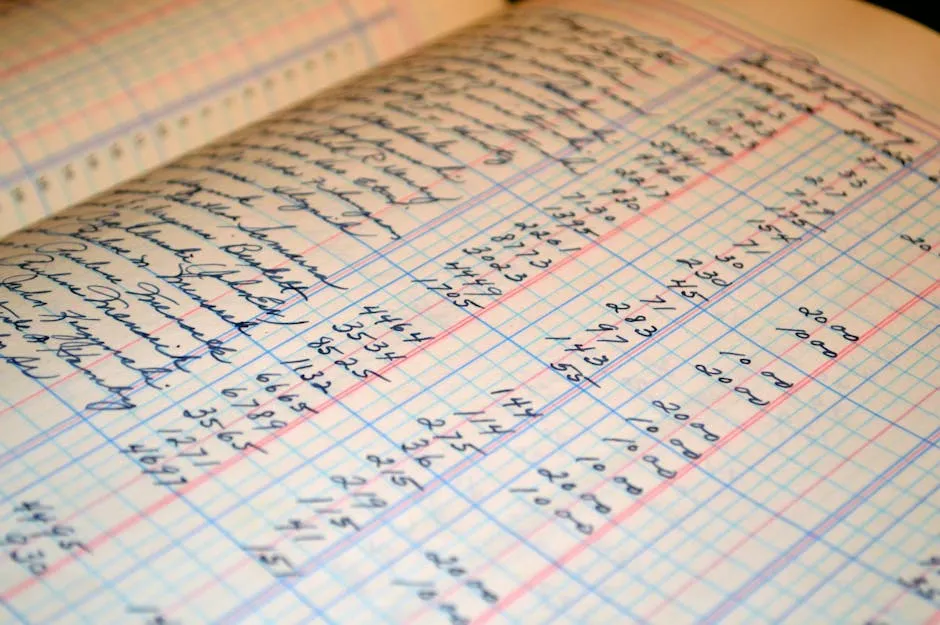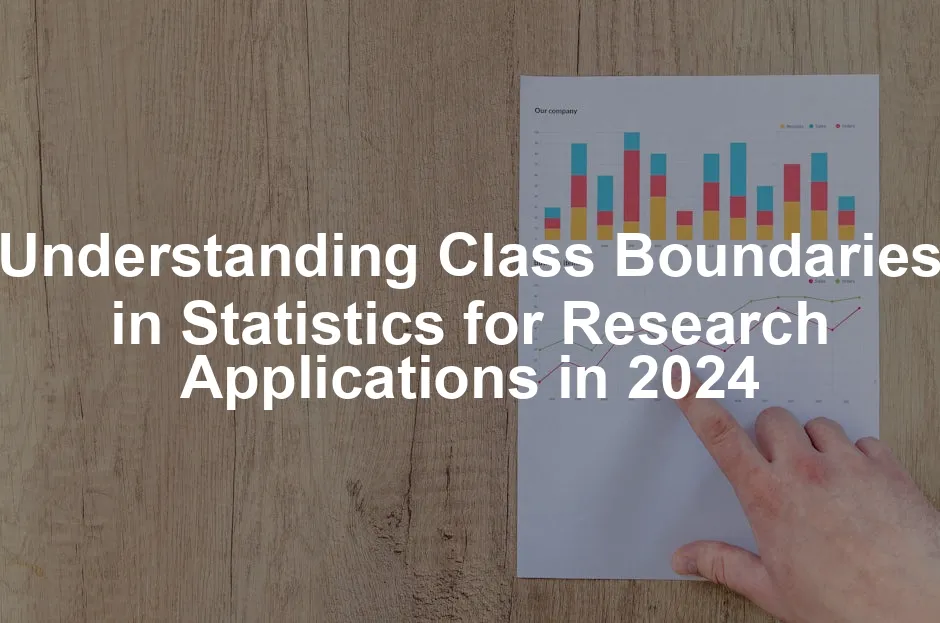In summary, understanding class boundaries not only simplifies data organization but also strengthens the reliability of statistical conclusions. As we navigate the complexities of data analysis in 2024, mastering this concept will undoubtedly elevate your research game. Read more about statistics class boundaries.
Understanding class boundaries is crucial for accurate statistical analysis. Learn more about their significance here.
How Class Boundaries Affect Frequency Distributions
Class boundaries are the unsung champions of frequency distributions. They define the precise limits of each class, ensuring data is categorized accurately. Imagine a world where scores overlap like socks in a laundry basket—what a disaster! Class boundaries keep those pesky overlaps at bay, creating clarity and order.
For instance, consider a dataset of ages: 20-30, 30-40, and 40-50. Without proper boundaries, a score of 30 might be confused about which class it belongs to. By setting boundaries at 19.5 and 30.5 for the 20-30 class, we solve the dilemma. Each score finds its rightful place without any confusion or ambiguity.
Here’s an example in action. Let’s say we’re analyzing test scores for a class of students:
| Class Interval | Frequency |
|---|---|
| 0-10 | 5 |
| 10-20 | 15 |
| 20-30 | 20 |
| 30-40 | 10 |
Now, let’s define the class boundaries:
- For 0-10: 0 – 10.5
- For 10-20: 9.5 – 20.5
- For 20-30: 19.5 – 30.5
- For 30-40: 29.5 – 40.5
With these boundaries, we can accurately represent the frequency distribution. It’s essential for continuous data representation, ensuring every score is correctly classified. Accurate class boundaries are vital in avoiding misinterpretation and maintaining the integrity of the analysis.

Visual Representation: Histograms
Histograms are like the visual party of data analysis! They bring frequency distributions to life using class boundaries. Creating a histogram is straightforward. First, define your class intervals and their corresponding frequencies. Then, set the class boundaries to ensure no data point is left out in the cold.
To draw a histogram, follow these steps:
- Draw Axes: The x-axis represents the class intervals, while the y-axis shows frequency.
- Mark Class Boundaries: Use the boundaries we calculated earlier.
- Draw Bars: For each class, draw a bar reaching up to its frequency.
Clear visualizations are crucial in data analysis. A histogram provides an instant snapshot of distribution patterns. It allows you to spot trends, outliers, or skewness at a glance. For instance, if most students scored between 20-30, the histogram will show a tall bar in that range, indicating a concentration of scores.
Interpreting histograms is just as fun! If you see a bell-shaped curve, congratulations! Your data may follow a normal distribution. A right-skewed histogram? It suggests that a few students scored exceptionally high. Understanding these patterns drives better decision-making and insights.
So, whether you’re creating a histogram for your latest research or just for fun, remember that class boundaries are your best friends in ensuring clarity and accuracy in your visual data storytelling. Speaking of visuals, if you’re in need of tools to help with data visualization, consider checking out Data Visualization: A Practical Introduction. This book will guide you through the essentials of presenting data effectively.
The Importance of Class Boundaries in Discriminant Analysis
Class boundaries are crucial in discriminant analysis, impacting classification accuracy significantly. When researchers categorize data into different groups, they rely on precise boundaries to determine which class a data point belongs to. Misclassification due to vague boundaries can lead to erroneous conclusions. Think of it like sorting laundry: if you’re not careful, you might toss a red sock in with the whites, and nobody wants pink laundry!
For example, let’s say we want to classify students based on their exam scores. If the class intervals are set at 60-70 and 70-80, the boundaries must be clearly defined. A score of 70 could fall into either class if boundaries aren’t set at 69.5 and 70.5. This ambiguity can create chaos in your analysis, resulting in mixed-up classifications.
To illustrate, consider a step-by-step example of applying discriminant analysis using class boundaries:
- Define Groups: We have two groups based on test scores: Group A (60-70) and Group B (70-80).
- Collect Data: Gather scores from students. Let’s say we have scores of 65, 70, 72, and 75.
- Set Class Boundaries: For Group A, the boundaries are 59.5 to 70.5; for Group B, they are 69.5 to 80.5.
- Classify Scores:
- Score of 65 → Group A (within boundaries)
- Score of 70 → Ambiguous; falls at the boundary.
- Score of 72 → Group B (within boundaries)
- Score of 75 → Group B (within boundaries)
This classification shows how critical clear boundaries are. They ensure that each score is correctly assigned, enhancing the accuracy of the overall analysis. In this way, class boundaries act as the gatekeepers of reliable data classification.

Case Studies and Research Applications
Discriminant analysis has found its way into various research scenarios, showcasing the impact of class boundaries. Take, for instance, a study on patient classifications in healthcare. Researchers used discriminant analysis to differentiate between patients based on their blood pressure and cholesterol levels.
In their analysis, class boundaries were set based on established health metrics. Patients with blood pressure readings of 120-130 and cholesterol levels of 200-220 were classified into distinct groups. By defining these boundaries precisely, researchers could accurately identify at-risk patients and recommend interventions.
Another compelling example comes from a marketing research study. Analysts employed discriminant analysis to segment customers based on purchasing behavior. They set boundaries for spending categories: low (under $50), medium ($50-$150), and high (over $150). Clear class boundaries allowed the company to tailor marketing strategies effectively, improving customer engagement.
These case studies illustrate that well-defined class boundaries are not just academic concepts; they are essential tools for real-world problem-solving. By ensuring accurate classifications, researchers can derive meaningful insights that drive decision-making in various fields, from healthcare to marketing. If you’re interested in honing your skills with practical examples, you might want to check out The Data Warehouse Toolkit, which provides excellent insights into dimensional modeling.

Environmental Science
Class boundaries play a vital role in analyzing environmental data. Researchers use these boundaries to categorize continuous data, such as temperature or pollution levels, into meaningful classes. This classification helps in monitoring environmental changes and identifying trends over time.
For instance, when studying air quality, researchers might set class intervals for pollutant concentrations. By establishing class boundaries, they can clearly define ranges like 0-50, 51-100, and so on. This organization simplifies the analysis of frequency distributions, making it easier to identify pollution spikes or improvements in air quality.
Moreover, class boundaries enhance the accuracy of visual data representations, like histograms. A well-constructed histogram can reveal patterns in environmental data that might otherwise go unnoticed. For example, a histogram illustrating rainfall distribution across seasons can highlight trends and inform resource management decisions. And to keep your workspace organized while doing this important work, consider a stylish Office Desk Organizer.
In summary, understanding class boundaries is crucial for environmental scientists aiming to analyze data effectively and drive informed decisions about sustainability and conservation efforts.

Business and Market Research
In the realm of business and market research, class boundaries are essential for understanding consumer behavior and market segmentation. By categorizing data into distinct classes, businesses can analyze purchasing patterns and preferences more effectively.
For example, a company may categorize customers based on their spending habits. Class intervals like $0-$50, $51-$100, and $101-$150 can help identify consumer segments. Each segment can then receive tailored marketing strategies to enhance engagement and sales.
Class boundaries also facilitate the creation of visual representations, like histograms, to depict how many consumers fall into each spending category. This visualization allows businesses to quickly assess which segments are thriving and which may need attention.
Furthermore, accurate class boundaries help businesses avoid misclassification of data points, ensuring that insights derived from analysis are reliable. In a world driven by data, understanding class boundaries gives businesses a competitive edge in targeting their audiences effectively. If you’re serious about diving into market research, consider R Programming for Data Science to enhance your analytical skills.

Education
In the educational sector, class boundaries are vital for grading systems and assessment analysis. Educators use these boundaries to categorize student performance into meaningful intervals, making it easier to interpret exam results and assign grades.
For instance, consider a grading scale where students are classified into ranges: 0-59 (F), 60-69 (D), 70-79 (C), 80-89 (B), and 90-100 (A). By defining clear class boundaries, teachers can quickly determine which students fall into each grade category. This clarity not only simplifies grading but also helps identify students who may need additional support.
Additionally, class boundaries can enhance the analysis of assessment data. By creating frequency distributions, educators can visualize how many students achieved specific grades. This insight can inform instructional strategies and curriculum adjustments to better meet student needs. Explore more on education statistics digest.
Class boundaries are essential in education for grading and assessment analysis. Learn more about their role in education statistics here.

Conclusion
In conclusion, class boundaries are a fundamental concept in statistics that allow researchers to categorize and analyze data effectively. As we have explored, they play a crucial role in ensuring that frequency distributions are accurate and meaningful, enhancing the clarity of data visualizations such as histograms. Moreover, class boundaries are vital in advanced statistical techniques like discriminant analysis, where accurate classification is essential for drawing reliable conclusions.
As we move further into 2024, a thorough understanding of class boundaries will empower researchers across various fields to harness the full potential of statistical analysis, ensuring that data-driven decisions are both informed and impactful. Their significance spans numerous domains, from environmental science to market research and education. By leveraging the power of class boundaries, professionals can achieve enhanced clarity in their analyses, leading to more effective decision-making.
The growing reliance on data in research and industry underscores the need for precise statistical methods. As researchers continue to navigate complex datasets, a strong grasp of concepts like class boundaries will be pivotal in deriving actionable insights. In this data-saturated world, ensuring that every data point finds its rightful place will ultimately contribute to informed and impactful outcomes in research and practice. And while you’re at it, don’t forget to keep your workspace cozy with an Ergonomic Office Chair for those long analysis sessions!

FAQs
What are class boundaries, and why are they necessary in statistics?
Class boundaries are the values that define the limits of class intervals in a dataset. They are crucial because they prevent overlaps between classes and eliminate ambiguity when categorizing continuous data. This precision improves the accuracy of statistical analyses and visualizations.
How do class boundaries differ from class limits?
Class limits are the actual endpoints of a class interval, while class boundaries are the values that lie halfway between the upper limit of one class and the lower limit of the next. For example, in the class interval 10-20, the class limits are 10 and 20, but the class boundaries would be 9.5 and 20.5.
Can class boundaries be used for qualitative data?
Class boundaries are primarily used for quantitative data, where ranges are necessary to categorize continuous variables. For qualitative data, categories are typically defined without the need for class boundaries since they represent distinct groups rather than ranges.
What common mistakes should one avoid when determining class boundaries?
Avoid overlapping intervals by ensuring that each data point falls within a specific range. Also, be cautious of gaps between classes, as they can lead to misclassification. Finally, ensure that class boundaries are consistently applied throughout the dataset for accurate analysis.
Please let us know what you think about our content by leaving a comment down below!
Thank you for reading till here 🙂
All images from Pexels
Introduction
In the bustling universe of statistics, class boundaries are like the trusty traffic signals guiding researchers through the chaotic intersections of data. They might not wear capes, but they certainly deserve some superhero credit! Class boundaries help transform a wild sea of numbers into neat, understandable groups. Without them, data would be akin to a jumbled sock drawer—confusing and frustrating.
As we venture into 2024, the urgency for precise data analysis is escalating. Researchers are demanding clearer interpretations of complex datasets. This is where class boundaries come into play. They help define the limits of data classes, ensuring that every data point finds its rightful home without overlap or ambiguity. Imagine trying to analyze test scores without clear boundaries; that would be a recipe for chaos!
This article will take you on an enlightening expedition through the world of class boundaries. We’ll uncover their significance in crafting frequency distributions, visualizing data with histograms, and applying them across various research domains. By the end, you’ll not only appreciate the role of class boundaries but also feel equipped to wield them effectively in your statistical endeavors.
So, grab your statistical compass, and prepare to navigate through the intricacies of class boundaries. Whether you’re diving into healthcare research, environmental studies, or market analysis, understanding these boundaries will empower you to make data-driven decisions with confidence. Get ready to transform the way you view data interpretation in 2024!

Understanding Class Boundaries
Definition of Class Boundaries
Class boundaries are the invisible lines that separate different groups in a dataset. Think of them as the bouncers at a fancy party, ensuring only the right guests (data points) get into the right rooms (classes). In statistics, class boundaries are crucial for defining the limits of each class interval in a frequency distribution. They help in categorizing continuous data without overlap or ambiguity.
Imagine you’re organizing a sock drawer. You wouldn’t want two socks from different pairs mingling! Class boundaries prevent such chaos by ensuring each data point has a designated spot. For example, if you have a class interval of 10-20, the boundaries might be set at 9.5 and 20.5. This setup ensures that a score of 10 falls into the right class and doesn’t accidentally wander into the next.
In practical terms, class boundaries enhance clarity in data representation. They eliminate confusion, making it easier to interpret results. Whether you’re analyzing test scores, survey responses, or any continuous data, understanding class boundaries is vital for accurate analysis.
If you’re looking to expand your knowledge on statistics, a great resource is Statistics for Dummies. This book breaks down complex concepts into bite-sized pieces, perfect for those new to the field.

How to Determine Class Boundaries
Finding class boundaries is simpler than it sounds! Here’s a step-by-step guide to make the process as easy as pie:
- Identify Class Limits: Start by identifying the upper limit of the lower class and the lower limit of the upper class. For instance, if you have the classes 10-20 and 20-30, your limits are 20 (upper of the first) and 20 (lower of the second).
- Calculate the Midpoint: To find the boundary, add the upper limit of the lower class to the lower limit of the upper class. In our example, that’s 20 + 20 = 40.
- Divide by Two: Take the midpoint from the previous step and divide it by two. So, 40 / 2 = 20. This gives you the class boundary.
- Adjust for Gaps: To ensure there are no gaps between classes, it’s common practice to set class boundaries at half the unit above and below the class limits. For the 10-20 class, the boundaries become 9.5 and 20.5.
This method ensures that when you create histograms, the data visualizations are clean and clear. Proper class boundaries allow for meaningful comparisons and interpretations. Eliminating gaps between classes is crucial, as it prevents misclassification of data points and maintains the integrity of your analysis.
For those keen on diving deeper into data science, consider picking up Data Science for Business. It offers insights into data analytic thinking that will enhance your statistical journey.

The Role of Class Boundaries in Frequency Distributions
Class boundaries play a pivotal role in the formation of frequency distributions. They define the intervals for grouping data, allowing researchers to analyze and interpret trends effectively. By categorizing data into distinct classes, class boundaries enhance clarity and precision in statistical analysis.
For example, consider a dataset of students’ test scores ranging from 0 to 100. If you group them into classes of 10, using class boundaries will help you accurately represent scores in the ranges of 0-10, 10-20, and so on. This method eliminates overlap, ensuring that each score is categorized correctly.
In summary, understanding class boundaries not only simplifies data organization but also strengthens the reliability of statistical conclusions. As we navigate the complexities of data analysis in 2024, mastering this concept will undoubtedly elevate your research game. Read more about statistics class boundaries.
Understanding class boundaries is crucial for accurate statistical analysis. Learn more about their significance here.
How Class Boundaries Affect Frequency Distributions
Class boundaries are the unsung champions of frequency distributions. They define the precise limits of each class, ensuring data is categorized accurately. Imagine a world where scores overlap like socks in a laundry basket—what a disaster! Class boundaries keep those pesky overlaps at bay, creating clarity and order.
For instance, consider a dataset of ages: 20-30, 30-40, and 40-50. Without proper boundaries, a score of 30 might be confused about which class it belongs to. By setting boundaries at 19.5 and 30.5 for the 20-30 class, we solve the dilemma. Each score finds its rightful place without any confusion or ambiguity.
Here’s an example in action. Let’s say we’re analyzing test scores for a class of students:
| Class Interval | Frequency |
|---|---|
| 0-10 | 5 |
| 10-20 | 15 |
| 20-30 | 20 |
| 30-40 | 10 |
Now, let’s define the class boundaries:
- For 0-10: 0 – 10.5
- For 10-20: 9.5 – 20.5
- For 20-30: 19.5 – 30.5
- For 30-40: 29.5 – 40.5
With these boundaries, we can accurately represent the frequency distribution. It’s essential for continuous data representation, ensuring every score is correctly classified. Accurate class boundaries are vital in avoiding misinterpretation and maintaining the integrity of the analysis.

Visual Representation: Histograms
Histograms are like the visual party of data analysis! They bring frequency distributions to life using class boundaries. Creating a histogram is straightforward. First, define your class intervals and their corresponding frequencies. Then, set the class boundaries to ensure no data point is left out in the cold.
To draw a histogram, follow these steps:
- Draw Axes: The x-axis represents the class intervals, while the y-axis shows frequency.
- Mark Class Boundaries: Use the boundaries we calculated earlier.
- Draw Bars: For each class, draw a bar reaching up to its frequency.
Clear visualizations are crucial in data analysis. A histogram provides an instant snapshot of distribution patterns. It allows you to spot trends, outliers, or skewness at a glance. For instance, if most students scored between 20-30, the histogram will show a tall bar in that range, indicating a concentration of scores.
Interpreting histograms is just as fun! If you see a bell-shaped curve, congratulations! Your data may follow a normal distribution. A right-skewed histogram? It suggests that a few students scored exceptionally high. Understanding these patterns drives better decision-making and insights.
So, whether you’re creating a histogram for your latest research or just for fun, remember that class boundaries are your best friends in ensuring clarity and accuracy in your visual data storytelling. Speaking of visuals, if you’re in need of tools to help with data visualization, consider checking out Data Visualization: A Practical Introduction. This book will guide you through the essentials of presenting data effectively.
The Importance of Class Boundaries in Discriminant Analysis
Class boundaries are crucial in discriminant analysis, impacting classification accuracy significantly. When researchers categorize data into different groups, they rely on precise boundaries to determine which class a data point belongs to. Misclassification due to vague boundaries can lead to erroneous conclusions. Think of it like sorting laundry: if you’re not careful, you might toss a red sock in with the whites, and nobody wants pink laundry!
For example, let’s say we want to classify students based on their exam scores. If the class intervals are set at 60-70 and 70-80, the boundaries must be clearly defined. A score of 70 could fall into either class if boundaries aren’t set at 69.5 and 70.5. This ambiguity can create chaos in your analysis, resulting in mixed-up classifications.
To illustrate, consider a step-by-step example of applying discriminant analysis using class boundaries:
- Define Groups: We have two groups based on test scores: Group A (60-70) and Group B (70-80).
- Collect Data: Gather scores from students. Let’s say we have scores of 65, 70, 72, and 75.
- Set Class Boundaries: For Group A, the boundaries are 59.5 to 70.5; for Group B, they are 69.5 to 80.5.
- Classify Scores:
- Score of 65 → Group A (within boundaries)
- Score of 70 → Ambiguous; falls at the boundary.
- Score of 72 → Group B (within boundaries)
- Score of 75 → Group B (within boundaries)
This classification shows how critical clear boundaries are. They ensure that each score is correctly assigned, enhancing the accuracy of the overall analysis. In this way, class boundaries act as the gatekeepers of reliable data classification.

Case Studies and Research Applications
Discriminant analysis has found its way into various research scenarios, showcasing the impact of class boundaries. Take, for instance, a study on patient classifications in healthcare. Researchers used discriminant analysis to differentiate between patients based on their blood pressure and cholesterol levels.
In their analysis, class boundaries were set based on established health metrics. Patients with blood pressure readings of 120-130 and cholesterol levels of 200-220 were classified into distinct groups. By defining these boundaries precisely, researchers could accurately identify at-risk patients and recommend interventions.
Another compelling example comes from a marketing research study. Analysts employed discriminant analysis to segment customers based on purchasing behavior. They set boundaries for spending categories: low (under $50), medium ($50-$150), and high (over $150). Clear class boundaries allowed the company to tailor marketing strategies effectively, improving customer engagement.
These case studies illustrate that well-defined class boundaries are not just academic concepts; they are essential tools for real-world problem-solving. By ensuring accurate classifications, researchers can derive meaningful insights that drive decision-making in various fields, from healthcare to marketing. If you’re interested in honing your skills with practical examples, you might want to check out The Data Warehouse Toolkit, which provides excellent insights into dimensional modeling.

Environmental Science
Class boundaries play a vital role in analyzing environmental data. Researchers use these boundaries to categorize continuous data, such as temperature or pollution levels, into meaningful classes. This classification helps in monitoring environmental changes and identifying trends over time.
For instance, when studying air quality, researchers might set class intervals for pollutant concentrations. By establishing class boundaries, they can clearly define ranges like 0-50, 51-100, and so on. This organization simplifies the analysis of frequency distributions, making it easier to identify pollution spikes or improvements in air quality.
Moreover, class boundaries enhance the accuracy of visual data representations, like histograms. A well-constructed histogram can reveal patterns in environmental data that might otherwise go unnoticed. For example, a histogram illustrating rainfall distribution across seasons can highlight trends and inform resource management decisions. And to keep your workspace organized while doing this important work, consider a stylish Office Desk Organizer.
In summary, understanding class boundaries is crucial for environmental scientists aiming to analyze data effectively and drive informed decisions about sustainability and conservation efforts.

Business and Market Research
In the realm of business and market research, class boundaries are essential for understanding consumer behavior and market segmentation. By categorizing data into distinct classes, businesses can analyze purchasing patterns and preferences more effectively.
For example, a company may categorize customers based on their spending habits. Class intervals like $0-$50, $51-$100, and $101-$150 can help identify consumer segments. Each segment can then receive tailored marketing strategies to enhance engagement and sales.
Class boundaries also facilitate the creation of visual representations, like histograms, to depict how many consumers fall into each spending category. This visualization allows businesses to quickly assess which segments are thriving and which may need attention.
Furthermore, accurate class boundaries help businesses avoid misclassification of data points, ensuring that insights derived from analysis are reliable. In a world driven by data, understanding class boundaries gives businesses a competitive edge in targeting their audiences effectively. If you’re serious about diving into market research, consider R Programming for Data Science to enhance your analytical skills.

Education
In the educational sector, class boundaries are vital for grading systems and assessment analysis. Educators use these boundaries to categorize student performance into meaningful intervals, making it easier to interpret exam results and assign grades.
For instance, consider a grading scale where students are classified into ranges: 0-59 (F), 60-69 (D), 70-79 (C), 80-89 (B), and 90-100 (A). By defining clear class boundaries, teachers can quickly determine which students fall into each grade category. This clarity not only simplifies grading but also helps identify students who may need additional support.
Additionally, class boundaries can enhance the analysis of assessment data. By creating frequency distributions, educators can visualize how many students achieved specific grades. This insight can inform instructional strategies and curriculum adjustments to better meet student needs. Explore more on education statistics digest.
Class boundaries are essential in education for grading and assessment analysis. Learn more about their role in education statistics here.

Conclusion
In conclusion, class boundaries are a fundamental concept in statistics that allow researchers to categorize and analyze data effectively. As we have explored, they play a crucial role in ensuring that frequency distributions are accurate and meaningful, enhancing the clarity of data visualizations such as histograms. Moreover, class boundaries are vital in advanced statistical techniques like discriminant analysis, where accurate classification is essential for drawing reliable conclusions.
As we move further into 2024, a thorough understanding of class boundaries will empower researchers across various fields to harness the full potential of statistical analysis, ensuring that data-driven decisions are both informed and impactful. Their significance spans numerous domains, from environmental science to market research and education. By leveraging the power of class boundaries, professionals can achieve enhanced clarity in their analyses, leading to more effective decision-making.
The growing reliance on data in research and industry underscores the need for precise statistical methods. As researchers continue to navigate complex datasets, a strong grasp of concepts like class boundaries will be pivotal in deriving actionable insights. In this data-saturated world, ensuring that every data point finds its rightful place will ultimately contribute to informed and impactful outcomes in research and practice. And while you’re at it, don’t forget to keep your workspace cozy with an Ergonomic Office Chair for those long analysis sessions!

FAQs
Please let us know what you think about our content by leaving a comment down below!
Thank you for reading till here 🙂
All images from Pexels




